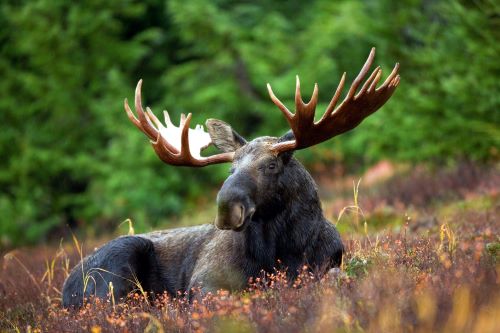
Moose are majestic and peaceful-looking animals that we’re lucky to see in wild spaces. But are moose dangerous? Like bears, they are unpredictable creatures that may not take kindly to our presence. And if you’re taking a long-distance hike or are in a remote area, you’re likely to see one. So what do you do when a moose comes your way? Here are our thoughts, as well as some helpful tips to stay safe during a moose encounter.
Unforeseen moose attack in Colorado Springs
On September 12, two hikers alongside their three dogs encountered a distressed cow moose on the Craigs Trail in Colorado Springs. According to the report, they spotted the moose about 1 mile into their hike in a scenic opening. Although the three dogs were leashed and the hikers did their best to move along the trail at a safe distance, the moose began to close in on them. As the moose neared, the dogs barked in response to the moose’s presence. This didn’t deter the moose, and the animal then trampled a hiker. Despite their efforts to escape the moose and flee, the persistent creature pursued them relentlessly along the trail.
After some time, they outran the moose and made it safely to their car. The injured individual was able to walk and the two then immediately headed to the hospital. Thankfully, their injuries were minor. The bull moose reportedly attacked because it was accompanied by a young calf. It’s well understood that when a moose is threatened by a predator, such as the barking dogs, it will defend its young at all costs.
This story serves as a stern reminder that it’s important to be aware of our surroundings when heading into wild spaces. Colorado Parks & Wildlife has responded to the incident by posting warning signs in areas with known moose activity, including the Craigs Trail.
But a moose encounter can happen anywhere, with their populations increasing by over one-third over the past decade. Here are a few tips for how to safely deal with a moose sighting if one of these creatures gets too close for comfort.

4 ways to stay safe when you encounter a moose
1. Keep your distance
The first thing you can do to avoid an altercation with a moose is to stay far away. A minimum of 50 yards is a good distance. If a moose is closer to you, such as one that has suddenly appeared by stepping out of the brush, slowly but confidently step away from it.
2. Make noise if you’re at a safe distance
If you’re not too close to startle the moose, make sure it knows you’re there by making noise. Since moose are herbivores and prey animals, they don’t have a natural instinct to attack, especially if they aren’t with their young. So when they hear you, they will likely walk away or hide rather than attack.
3. Keep an eye out for signs of aggression
Knowing how to identify signs of stress and aggression will help you assess how serious the situation is. When a moose is feeling threatened, you’ll notice the following physiological signs:
- Raised or spiked hair on the back of the body
- Ears lowered or pinned to the back of the head
- A lowered head position
- Snout licking and snorting
If you notice a moose expressing any of these signs, the moose is likely agitated. Prepare to move away quickly and for the possibility of an attack.
4. React quickly if the moose charges
If a moose begins to charge, act fast and run in the opposite direction. Try to put an object, such as a large rock or tree, between you and the animal, and consider running in a zigzag pattern if possible.
Bears are known for chasing people quite far, so you need to act fast and have a lot of longevity to avoid a bear attack. Moose tend to give up much more quickly. So run until you tire the animal out, or hide behind a tree or boulder after you’ve established enough distance.
Stay safe and avoid a moose attack
This isn’t the first moose incident that’s occurred in Colorado or the U.S. this year, and In Yellowstone National Park, one woman was sent running after yet another too-close encounter with a bison. With accidents on the rise, it’s important to remember basic safety procedures that keep both you and these creatures safe.
So check out this safety video produced by the Colorado Parks & Wildlife team so you feel well prepared if are moose aggressive on your next trip. And follow the above tips to make sure you and your loved ones stay safe in the great outdoors.



